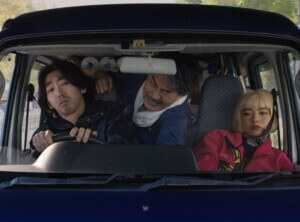“Well, that’s Columbus—meth and modernism,” quips 19-year-old protagonist Casey (Haley Lu Richardson), in the new independent film Columbus. Directed by Kogonada, the movie centers on Columbus, Indiana, so much so that the city and its architecture functions as a character equal to the actors (and of course, lending itself to the film’s title). In context, her remark isn’t a flippant dismissal of the town but a reflection of larger issues Kogonado contemplates in his work.
“Do forms make a difference? Do buildings make our lives better even when they are bad?” This is a particularly apt question to ask in a city like Columbus, which, although known for its architecture, is not exactly known as a cultural hotspot.
It is rare that architecture features so heavily in what is otherwise a clever coming-of-age tale, but even the plot emerged from the city’s buildings. Kogonada was inspired by visiting the southern Indiana city and wrote the script based on his observations. “The City of Columbus had to give us permission to film there, or else we wouldn’t have made the film,” Kogonada said in a discussion following a screening at BAM.
Scenes center on, around, and in the soaring modernist works by Eliel and Eero Saarinen, I.M. Pei, and Deborah Berke, as Casey rapidly gains aesthetic awareness and an appreciation for architecture as she grapples with staying in her hometown and taking care of her mother (a recovering meth addict) while her friends go off to college. She encounters Jin (John Cho), a Korean-American translator who comes to the city to care for his father, a noted architectural historian who falls critically ill while visiting Columbus; the pair form a relationship. The plot itself is charming and smart, but it is the film’s pacing, styling, and setting that elevate it to what the New Yorker has described as “precocious genius.”
Kogonada incorporates the architecture both blatantly and subtly. Throughout, Casey names and describes each building to Jin, a newcomer to Columbus—Eliel Saarinen’s First Christian Church, I.M. Pei’s Cleo Rogers Memorial Library, Eero Saarinen’s Miller house, the Irwin Conference Center, and North Christian Church, Deborah Berke’s Irwin Union Bank, and Robert A.M. Stern’s Columbus Regional Hospital, among others. Those structures not explicitly labeled still loom prominently in the setting.
Architectural themes also permeate the film, most notably the exploration of absence and presence, void and volume. Kogonada explores this several different ways: Whenever music plays, there is an absence of dialogue; when Jin speaks Korean, there is an absence of subtitles; characters refer to plot moments that never came up; and at times there is silence even though the audience can see that the person is speaking.
Other questions are grappled with, as well: “Can architecture heal?” “Do the buildings we grow up around inform our views of the world?” “What makes modernism important?” They are good questions and ones that the architectural, art, and design communities debate often, but in Columbus they are opened up to the layperson and architecture aficionado alike.
For screenings and more information, see the film’s website.










